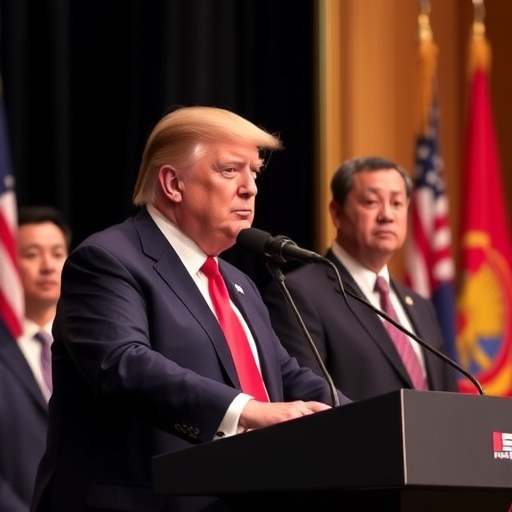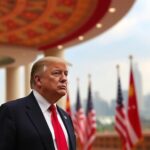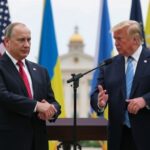ASEAN Summit 2025 Launches in Kuala Lumpur as Trump Reaffirms US Commitment to Southeast Asia Amid Trade Tensions
In a bold display of diplomatic resolve, the ASEAN Summit 2025 opened its doors in Kuala Lumpur today, with U.S. President Donald Trump delivering a keynote address that pledged unwavering American support for Southeast Asia. Amid escalating global tensions, including ongoing conflicts in the Middle East and uncertainties in U.S.-China relations, Trump’s speech emphasized the strategic importance of the region, vowing to counterbalance influences from Beijing through enhanced economic and security partnerships. This comes at a critical juncture as ASEAN nations grapple with the ripple effects of U.S. tariffs on Asian economies, making the summit a pivotal arena for reshaping regional dynamics.
- Trump’s Fiery Keynote Ignites Hopes for US-ASEAN Trade Revival
- Regional Security Discussions Heat Up Over South China Sea Disputes
- Tackling Supply-Chain Vulnerabilities in the Face of Global Disruptions
- US Tariffs’ Double-Edged Impact on Southeast Asian Economies
- Charting the Path Forward: Emerging Deals and Long-Term Alliances
The event, hosted by Malaysia as the rotating chair of the Association of Southeast Asian Nations (ASEAN), draws leaders from all 10 member states—Brunei, Cambodia, Indonesia, Laos, Malaysia, Myanmar, the Philippines, Singapore, Thailand, and Vietnam—alongside key dialogue partners like the United States, China, Japan, and the European Union. With over 2,000 delegates in attendance, the summit is expected to generate discussions worth billions in potential trade deals, underscoring Southeast Asia’s role as a global economic powerhouse projected to grow at 4.6% in 2025 according to the International Monetary Fund (IMF).
Trump’s presence marks a significant return to the region following his first-term engagements, signaling a renewed focus on ASEAN amid criticisms that previous administrations neglected the bloc’s potential. "Southeast Asia is not just a partner; it’s the future of free trade and security in the Indo-Pacific," Trump declared, drawing applause from the audience. This pledge arrives against the backdrop of U.S. tariffs imposed on Chinese goods, which have inadvertently boosted ASEAN exports by 15% in the past year, per data from the ASEAN Secretariat.
Trump’s Fiery Keynote Ignites Hopes for US-ASEAN Trade Revival
President Trump’s opening remarks set the tone for the entire summit, blending his signature bravado with concrete policy proposals aimed at bolstering trade ties. Speaking from the opulent Putra World Trade Centre, he highlighted how U.S. investments in Southeast Asia have surged by 25% since 2020, reaching $300 billion cumulatively. "We’re talking real deals here—factories, tech hubs, and jobs that will make America and ASEAN stronger together," Trump stated, referencing initiatives like the U.S.-ASEAN Comprehensive Strategic Partnership launched in 2022.
The address delved into specifics, promising streamlined visa processes for ASEAN business travelers and a $10 billion infrastructure fund to enhance connectivity across the region. This fund would target key projects such as the ASEAN Power Grid and digital trade corridors, addressing bottlenecks that currently cost the bloc an estimated $50 billion annually in lost efficiency, according to a World Bank report. Trump’s emphasis on trade resonated deeply, especially as ASEAN’s total trade volume with the U.S. hit $400 billion in 2024, making it America’s fifth-largest trading partner.
Yet, the speech wasn’t without controversy. Trump reiterated his administration’s tariff strategy, defending the 10-25% levies on imports from non-compliant nations as necessary to protect American workers. For Southeast Asian leaders, this is a double-edged sword: while tariffs on China have diverted supply chains to countries like Vietnam and Indonesia—whose electronics exports to the U.S. jumped 30% last year—they also raise fears of collateral damage if U.S. policies expand. Indonesian President Joko Widodo, in a post-speech interview, noted, "We welcome U.S. support, but predictability in trade is key to our shared prosperity."
Behind the scenes, bilateral meetings are already yielding fruits. Sources close to the delegation reveal that Trump held private talks with Malaysian Prime Minister Anwar Ibrahim on expanding semiconductor collaborations, potentially creating 100,000 jobs in the region. This aligns with broader U.S. efforts to diversify away from China-dependent supply chains, a theme echoed in the summit’s agenda.
Regional Security Discussions Heat Up Over South China Sea Disputes
As the summit progresses, regional security has emerged as a flashpoint, with ASEAN leaders united in their call for a rules-based order in the South China Sea. Trump’s pledge included bolstering maritime security cooperation, promising $5 billion in military aid over the next five years to enhance ASEAN navies’ capabilities. This is particularly timely, given that China’s assertive claims have led to over 100 incidents involving Philippine vessels in the past year alone, as reported by the Asia Maritime Transparency Initiative.
The discussions under the ASEAN Security Community pillar focus on de-escalating tensions without alienating Beijing, a delicate balance for the bloc. Vietnamese Prime Minister Pham Minh Chinh stressed in a panel session, "Peace in the South China Sea is essential for our economic miracle; we seek dialogue, not division." Trump’s response was unequivocal: the U.S. would conduct more freedom of navigation operations and support ASEAN’s Code of Conduct negotiations with China, which have stalled since 2017.
Statistics paint a stark picture of the stakes. The South China Sea handles $3.4 trillion in annual trade—over one-third of global maritime commerce—making it a vital artery for Southeast Asia’s export-driven economies. Disruptions here could shave 1-2% off ASEAN’s GDP growth, per ASEAN economic forecasts. In light of this, the summit is exploring joint patrols and intelligence-sharing pacts, with the U.S. offering advanced radar systems to nations like the Philippines and Singapore.
Myanmar’s ongoing civil strife also factored into security talks, with Trump announcing humanitarian aid packages worth $200 million while urging ASEAN to enforce its own consensus-based approach to the crisis. This reflects a broader U.S. strategy to position itself as a reliable security guarantor, contrasting with perceptions of China’s more transactional engagements.
Tackling Supply-Chain Vulnerabilities in the Face of Global Disruptions
Supply-chain resilience dominated afternoon sessions, as ASEAN grapples with the legacies of the COVID-19 pandemic and geopolitical shocks. Trump’s administration highlighted its "Friendshoring" initiative, encouraging U.S. firms to relocate operations to trusted partners like ASEAN countries. Data from the U.S. Trade Representative shows that American companies have already shifted $100 billion in investments to the region since 2021, particularly in electronics and pharmaceuticals.
Key proposals include establishing an ASEAN-U.S. Supply Chain Forum to standardize regulations and reduce redundancies. "We’ve seen too many bottlenecks—chips shortages, port delays—that hurt everyone," said U.S. Commerce Secretary Gina Raimondo in a virtual address, noting that ASEAN ports handled 130 million TEUs (twenty-foot equivalent units) in 2024, a 10% increase from pre-pandemic levels. Challenges persist, however, with climate events like Typhoon Yagi in 2024 disrupting Vietnamese manufacturing hubs and costing $1.5 billion.
Speakers from the private sector, including executives from Intel and Procter & Gamble, shared success stories of onshoring to Thailand and Malaysia, where labor costs are 30-40% lower than in China. Yet, experts warn of skill gaps: a McKinsey report estimates that Southeast Asia needs 2.5 million additional digital workers by 2025 to sustain this momentum. The summit is addressing this through vocational training pledges, with the U.S. committing $500 million to upskill programs in AI and green technologies.
Trade imbalances were also scrutinized. While U.S. exports to ASEAN grew 8% last year, imports surged 20%, prompting calls for fairer access. Singapore’s Trade Minister Gan Kim Yong advocated for "mutual vulnerability reduction," proposing tariff exemptions on critical minerals like rare earths, 80% of which are currently sourced from China-dominated supplies.
US Tariffs’ Double-Edged Impact on Southeast Asian Economies
The elephant in the room remains the U.S. tariff regime, which Trump defended as a tool for equitable trade. Imposed under Section 301 since 2018, these duties have reshaped ASEAN’s export landscape: Vietnam’s trade surplus with the U.S. ballooned to $100 billion in 2024, fueled by relocated factories from apparel to EVs. However, this windfall isn’t uniform—smaller economies like Laos and Cambodia face higher compliance costs, with tariffs adding 5-10% to their export prices.
Economists at the summit cited IMF projections showing that prolonged tariffs could slow ASEAN growth to 4% if retaliatory measures escalate. "Tariffs protect jobs at home but risk fragmenting global trade," warned Dr. Maria Mendoza, a trade analyst from the Philippines Institute for Development Studies. Trump’s counter was a proposed ASEAN Trade Facilitation Agreement, aiming to cut non-tariff barriers by 50% and boost intra-regional trade, which currently stands at just 25% of total ASEAN commerce.
Bilateral spotlights included U.S.-Indonesia negotiations on palm oil and nickel exports, critical for EV batteries. Indonesia, the world’s top nickel producer, seeks tariff relief to double its U.S. shipments to $20 billion by 2030. Meanwhile, Thailand lobbied for auto sector exemptions, as its pickup truck exports—valued at $15 billion annually—face 25% duties. Quotes from Thai Commerce Minister Phumtham Wechayachai underscored urgency: "We need U.S. markets open to fuel our recovery."
Broader implications involve WTO compliance. ASEAN is pushing for dispute resolution mechanisms to prevent tariff wars, drawing on past successes like the 2023 U.S.-Vietnam trade pact that resolved $2 billion in disputes.
Charting the Path Forward: Emerging Deals and Long-Term Alliances
As the summit enters its second day, momentum builds toward concrete outcomes. Preliminary agreements include a U.S.-ASEAN Digital Economy Framework, targeting $1 trillion in e-commerce by 2030, and enhanced climate cooperation under the Just Energy Transition Partnership. Trump’s closing remarks hinted at a potential U.S.-ASEAN free trade area talks kickoff in 2026, which could add 0.5% to regional GDP annually, per ADB estimates.
Leaders are optimistic about sustained U.S. engagement, especially with elections looming in key ASEAN nations like Indonesia next year. "This summit reaffirms ASEAN’s centrality in a multipolar world," said Malaysian Foreign Minister Mohamad Hasan. Forward-looking, the focus shifts to implementation: monitoring tariff impacts through annual reviews and scaling security pacts to include cyber defenses against rising threats.
The Kuala Lumpur gathering not only revitalizes U.S.-Southeast Asia ties but positions ASEAN as a bridge in global trade. With Trump’s pledges translating to action, the region stands poised for a decade of resilient growth, navigating tensions with strategic foresight.








